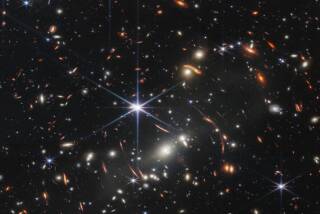Surprise! The universe has 10 times as many galaxies as scientists thought
The universe just got a lot more crowded. Astronomers using NASA’s Hubble Space Telescope say that there are around two trillion galaxies in the cosmos — at least 10 times higher than previously thought.
The findings, to be published in the Astrophysical Journal, shed light on the evolution of the structure universe, and hint at the possible nature of dark matter.
“We now know that there are at least 10 times more galaxies in the universe than we had thought for the last 20 years, and before that we didn’t really have any idea,” said lead author Christopher Conselice, an astrophysicist at the University of Nottingham. “So the more we learn about the universe ... the more interesting it becomes.”
The universe has a certain structure: Planets circle stars, which spin or hover in galaxies, which themselves travel in galaxy clusters, which appear to be held together by an enormous web of dark matter. The galaxy is a basic unit of that cosmic web, and so in order to understand the structure and nature of the universe, scientists need to understand the galactic population within it. Were they large and bright? Were they small and dim? What was their shape? And have those demographics shifted over time?
Luckily, astronomers have a tried-and-true method of looking back in time — by looking deeper and farther into space. Light from the sun takes about eight minutes to travel 93 million miles to Earth, so the image we see of the sun right now is actually the sun as it was eight minutes ago. The same guideline applies as you probe much deeper into space: If we look at a galaxy that’s 3 billion light-years or so away, we’re seeing it not as it is today, but as it was 3 billion years ago.
About two decades ago, the Hubble Space Telescope took some of the deepest pictures of the distant, early cosmos, revealing what our 13.8-billion-year-old universe looked like in its childhood, more than 10 billion years ago. Extrapolating from the galaxies filling a patch of sky, astronomers calculated that the universe must hold around 100 billion galaxies. (Estimates range from about 100 billion to 200 billion, Conselice said.)
Incredible as those images were, the Hubble Deep Field images had their limits, Conselice said. The Hubble images were taken in optical light, which limits how far into space (and thus, into the past), astronomers could see. Longer wavelengths of near-infrared light, on the other hand, would allow them to look much deeper.
Using the Hubble Space Telescope’s Wide Field Camera 3, which can observe the cosmos in near-infrared wavelengths, Conselice and colleagues were able to look back at different depths of space, putting together a three-dimensional map of space going back about 13 billion years in time.
They found that unlike the universe today, the early universe was dominated by an overwhelming number of small galaxies. This doesn’t mean that there was more mass in the universe before, he added — it was just packaged differently.
“The total mass is not increasing. It’s just how that mass is distributed is changing,” he said. “The population is dominated much more by these lower-mass galaxies in the distant universe than what we have in the local universe [today].”
The astronomers think that this supports the idea that the universe was built from the bottom up, with smaller galaxies growing or glomming together into fewer, larger galaxies over time.
Scientists are also trying to understand the nature of dark matter — invisible mass that can’t be seen and doesn’t interact with normal matter, but which far outweighs the amount of normal matter in the universe and whose gravitational influence helps determine the large-scale structure of the cosmos.
If galaxies started out small and plentiful, and then grew and consolidated over time, it would support an idea called the ”cold” dark matter hypothesis over the ”hot” dark matter one, Conselice said.
Scientists are also looking forward to the launch of NASA’s James Webb Space Telescope in 2018, which will be able to look deeper into the infrared — and so even farther back in time and space.
The James Webb telescope will “more than double the number of galaxies that we can see today — so explore a whole new regime of galaxies that we cannot study yet,” Conselice said.
Follow @aminawrite on Twitter for more science news and “like” Los Angeles Times Science & Health on Facebook.
MORE IN SCIENCE:
Tiny craters, big impact: The moon’s surface may be more dynamic than once thought
The most sought-after drug in the Ebola crisis failed to prove it helped patients
Cosmic radiation may leave astronauts with long-term cases of ‘space brain,’ study says





